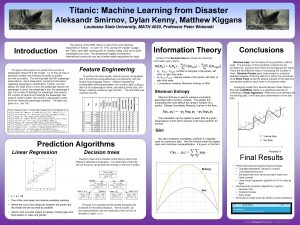Titanic Machine Learning from Disaster Aleksandr Smirnov Dylan

- Slides: 1

Titanic: Machine Learning from Disaster Aleksandr Smirnov, Dylan Kenny, Matthew Kiggans Louisiana State University, MATH 4020, Professor Peter Wolenski Introduction The sinking of the RMS Titanic is one of the most infamous shipwrecks in history. On April 15, 1912, during her maiden voyage, the Titanic sank after colliding with an iceberg, killing 1502 out of 2224 passengers and crew. This sensational tragedy shocked the international community and led to better safety regulations for ships. The goal of the project is to predict the survival of passengers based off a set of data. To do this we train a prediction system and evaluate its ability to predict survival accurately. The training data had 891 passenger observations. Each observation contained information regarding passenger’s identification number, survival status, the class level in which the passenger stayed, the passenger’s name, the passenger’s sex, the passenger’s age, the number of siblings the passenger had present, the number of parents and siblings the passenger had present, ticket number, fare amount, passenger’s cabin, and from where the passenger boarded. The data was given in a “. csv” file. Feature Engineering To achieve the best results, data should be manipulated into a format that works effectively and efficiently with the programing language Python. Feature engineering encapsulates altering alphabetic into numeric data, pulling a title out of a passenger’s name, calculating family size, and filling in missing values for age and fare. The final data was machine friendly. Information Theory Nodes in the decision tree are chosen to maximize information gain criteria. Conclusions Decision trees are the basis of the prediction method used. The accuracy of this prediction method can be increased by growing more trees and averaging their result. There are two effective ways of increasing the number of trees. Random Forests grow trees based on randomly selected subsets of training data from within the overall set, while Extra Trees randomly selects subsets of the data and use random splits for each node in its decision trees. Averaging results from several decision trees helps to deal with overfitting. Below is a graphical example of overfitting in linear regression. While the curve perfectly fits the training data, it will have poor performance on the test data. Prediction Algorithms Linear Regression Decision trees Final Results Decision trees show possible outcomes by examining different methods of evaluation. The branches of the tree can be found by using Shannon entropy or the Gini function. Entropy Female Class 1 or 2 Male Class 3 Class 1 Class 2 or 3 Gini • Performed featured engineering techniques • Changed alphabetic values to numeric • Calculated family size • Extracted title from name and deck label from ticket number • Used linear regression algorithm to fill in missing ages • Used several prediction algorithms in python • Decision tree • Random forests • Extra trees • Achieved our best score 80. 383% correct predictions The goal is to progress till the lowest entropies are achieved for the best prediction. Here it is seen, an accurate prediction can be made about the survival of females in class 1 or 2. www. postersession. com

